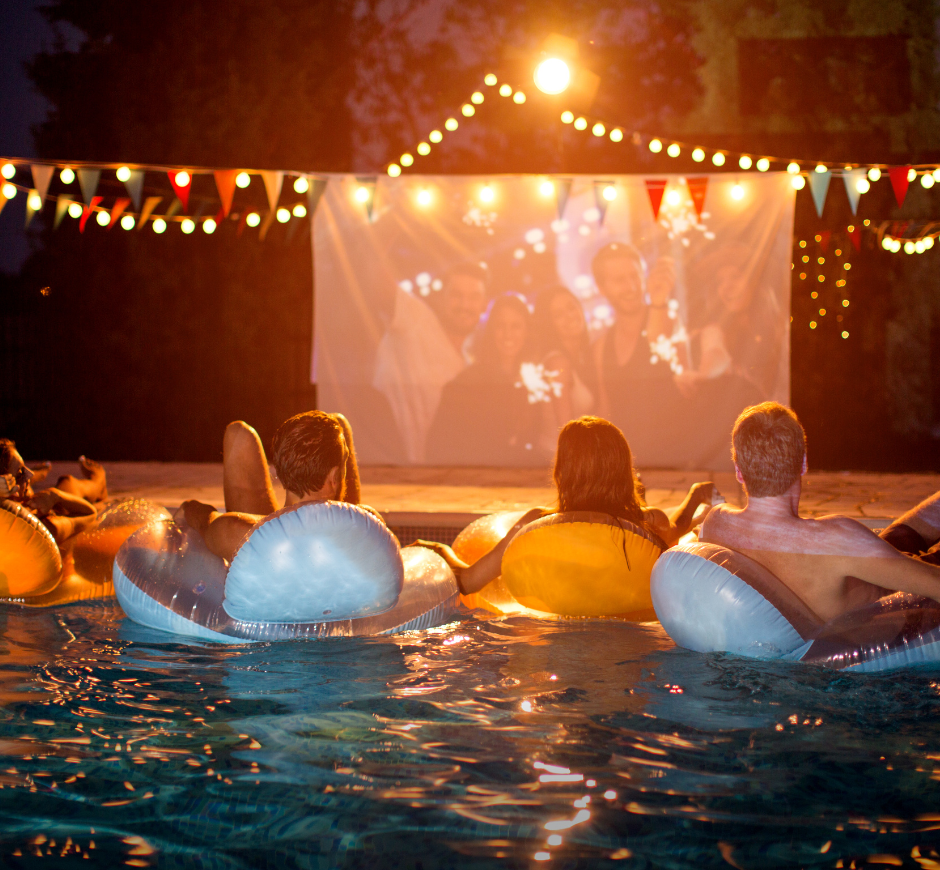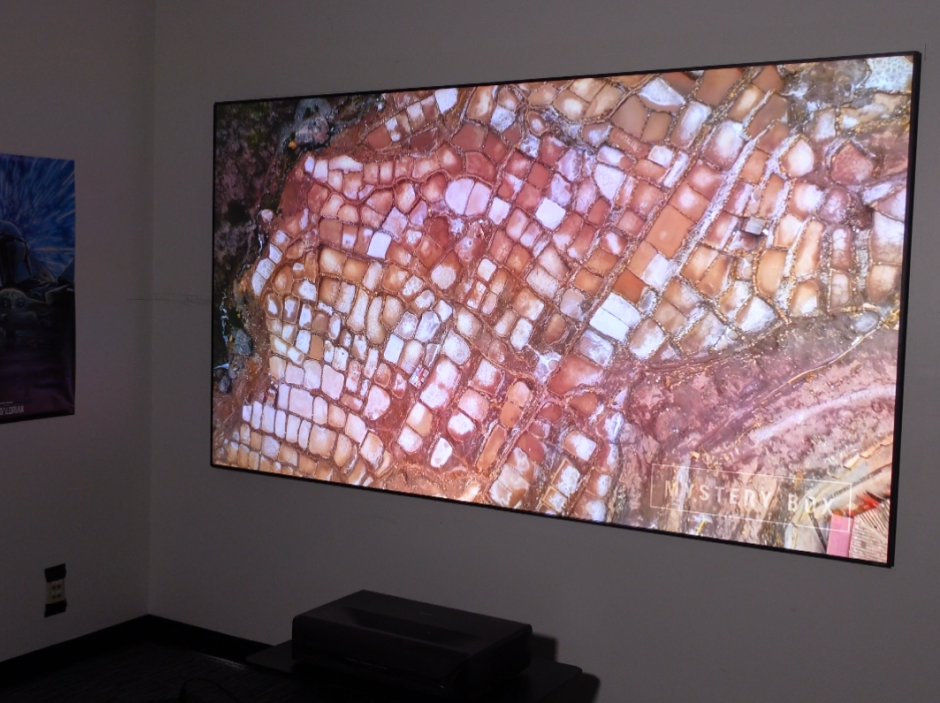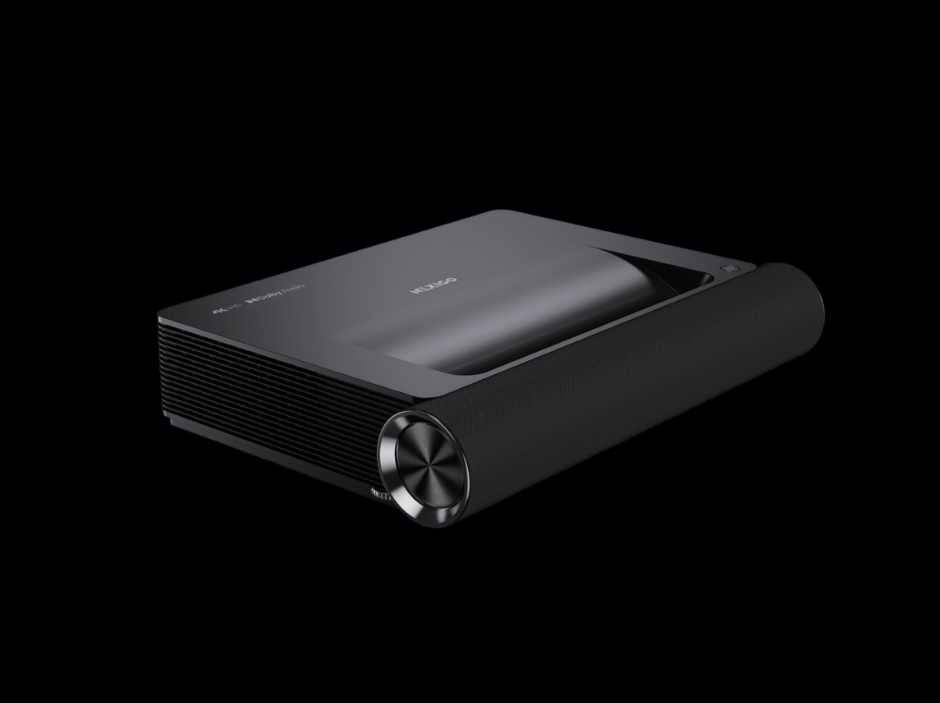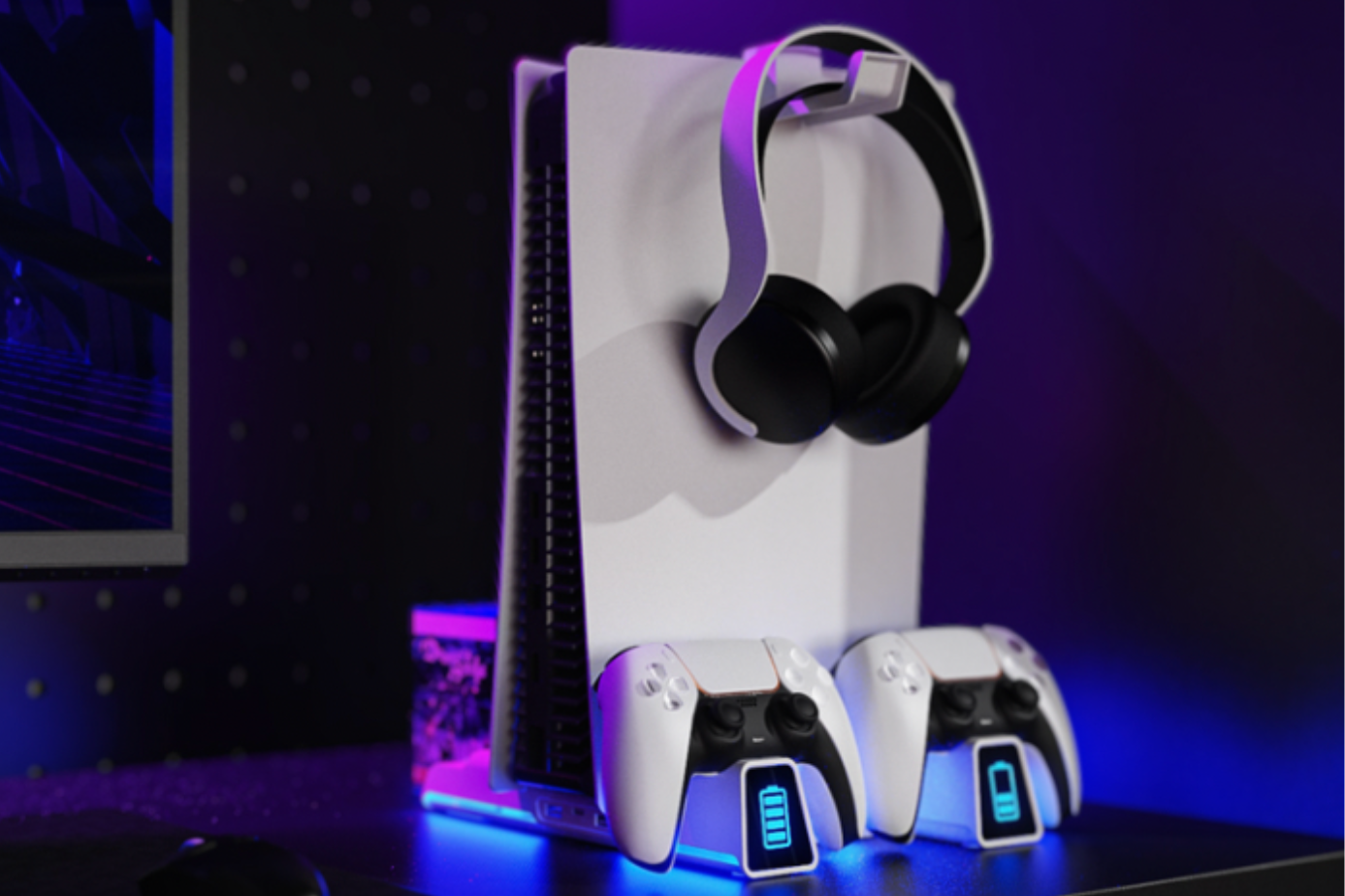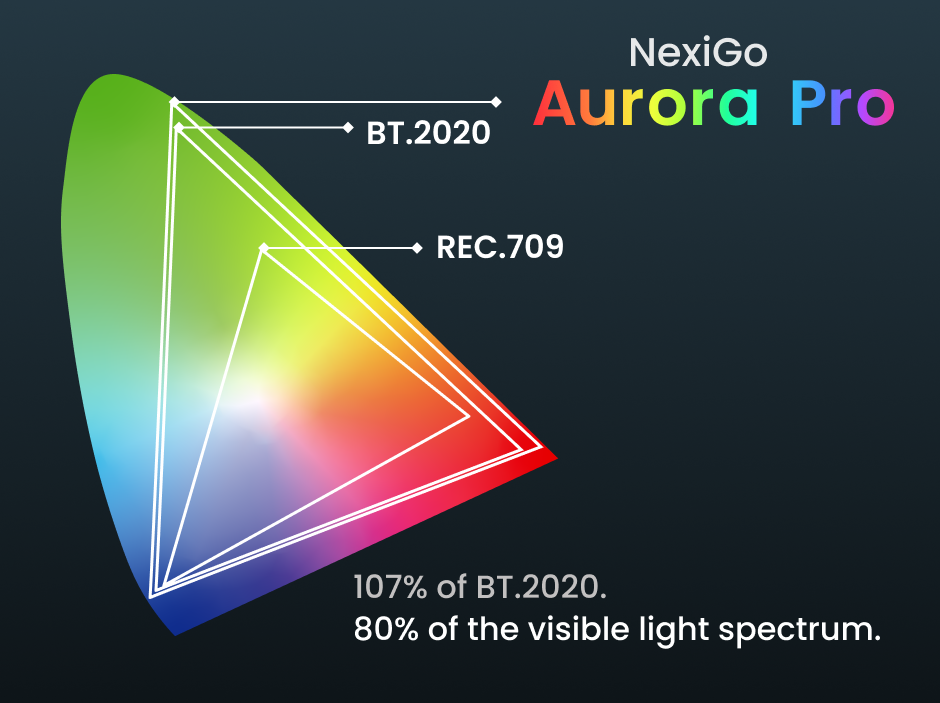
Aurora Pro: Expertly Calibrated For An Impressive Color Gamut
Amber Stefanson | Sep 21, 2023
Color has the power to delight and inspire.
Think of a time in your life when you’ve seen a particularly beautiful sunset. The captivating gradients of oranges, pinks, purples demand your attention. Your eyes linger on it much longer than they would on an ordinary blue or gray sky. Maybe you even decide to photograph it to share the experience with your friends.
If you’ve ever been in this situation without professional equipment on hand, you must be well-acquainted with the disappointing reality of photographing a sunset: your cellphone can never capture color in the same exact way that you see it. The resulting image will be dull and either too bright or too dark — a bland specter of the brilliant sight before you.
TVs and projectors can have the same effect without a professionally calibrated color gamut. With a low-quality display, the colors in your movies and video games might appear dull, lifeless, and overly bright or dark.
The Aurora Pro is different. It reproduces color from movies and video games with lifelike accuracy, using a level of vibrance that’s indistinguishable to the human eye from the real thing. With its exceptional color accuracy (ΔE>3), wide color gamut (107% BT.2020), and high contrast (3000:1, or 5000:1 with Dynamic Black), you can rest assured that when you watch a sunset on the Aurora Pro, you’re seeing it in full color: the way it deserves to be seen.
Why Does Color Accuracy Matter?
A lot of work goes into making a movie, tv show, or video game to look the way it does. Video editors spend many hours adjusting the color grading of each scene to influence the mood and balance of the film to fit the director’s vision. Cooler colors may evoke tension, while warmer colors may evoke passion. When the color balance is off, the full emotional impact of the scene may be weakened.
Two Mona Lisas: How Detail Gets Lost
To see how a display with poor color accuracy could affect your movie-watching experience, compare Da Vinci’s Mona Lisa to the “Prado” copy, which was painted by one of Da Vinci’s apprentices under his instruction, using the same materials at the same time.

Mona Lisa (Louvre)

Mona Lisa (Museo del Prado)
While the Da Vinci Mona Lisa that hangs in the Louvre has yellowed with age, her twin that was painted at the same time remains mostly the same as Da Vinci intended.
This is because the Prado Mona Lisa was covered by another layer of paint and varnish for hundreds of years. This layer protected the original paint from oxidation, so the Prado Mona Lisa never faded or yellowed.
Once the extra layer of varnish was removed, the original colors were revealed — granting insight into what Da Vanci’s Mona Lisa would have looked before the paint started to yellow. Notice how much more detail stands out when the color was accurate to the painter’s original vision.

Mona Lisa (Louvre)

Mona Lisa (Museo del Prado)
Mona Lisa’s expression is transformed by the presence of her eyebrows. She appears coy and intelligent. Subtle details are uncovered, from the perfect ringlets in her hair to the dimensional sheerness of her gossamer shawl. The blues of the sky and the pink flush in her cheeks are recovered, giving life to the picture.

Mona Lisa (Louvre)

Mona Lisa (Museo del Prado)
When the paint is oxidized, the entire image is duller, yellower, and lower contrast. As you can see, so much detail and emotion is left out when we lose color accuracy in art. And a low-quality display can have the same effect on the media you consume.
Have you ever died in an fps game because you were unable to see an enemy lurking in the shadows? Or perhaps your horror movie experience was ruined by a murky picture quality every time the scene got too dark. These are just a few examples of the negative impact that poor contrast and dynamic range can have on your media-watching experience.
Auteur Filmmakers and Creative Intent
Similarly, you wouldn’t want to watch a movie on a screen with inaccurate color. Many directors use color and contrast as a central component to their craft. Wes Anderson’s signature combination of pastel and jewel tones require a wide spectrum of color to fully enjoy. Without his stylistic palettes, the pieces don’t quite fall into place.

Asteroid City (2023)

Asteroid City (2023)
With a low-quality screen
Contrast plays a big role in screen quality, too. Alex Garland’s Men wouldn’t be the same without its high contrast and large shadowy areas to evoke a sense of tension.

Men (2022)

Men (2022)
With a low-quality screen
It is our passion to bring these colors to life on the Aurora Pro, recreating your favorite scenes in the exact way that the director intended them to be seen.
How To Measure Color
To ensure that the Aurora Pro has the most accurate color possible, we measured its light source against the following metrics.
- BT.2020 (107% BT.2020)
- Delta-E (ΔE≈1)
- Contrast Ratio (3000:1, 5000:1)
- EOTF (more on this later)
These metrics put a science to the subjective experience of color, carefully mapping out the hue, depth, and efficiency of each color. Let’s go over a few of the ways that we measured the Aurora Pro to ensure peak quality and color performance.
BT.2020 vs Rec.709: Widening the Color Gamut
The Aurora Pro covers 107% of the BT.2020 color gamut. To understand what this means, it’s important to know that BT.2020 and Rec.709 are two different standards you can use to measure a display against the spectrum of light visible to the human eye.
Rec.709

Image Credit: Wikipedia
BT.2020

Image Credit: Wikipedia
Rec.709 is an older standard that has been in use since the 90s. It covers approximately 35.9% of the visible light spectrum, which doesn’t sound impressive, but it’s the gold standard for broadcasting.
BT.2020, which was published in 2012, covers 75% of the visible light spectrum. Images using BT.2020 are noticeably brighter, higher contrast, and more saturated. Meanwhile, images using Rec.709 are noticeably duller, especially in the blue-green range.

Greens are limited in Rec.709 compared to BT.2020 (Image Credit: XDA)
BT.2020 is a much wider and more versatile gamut, but displays that can meet this standard have been slow to release. We are proud to announce that the Aurora Pro covers 107% of BT.2020, reproducing a total of 80% of the visible spectrum of light.
Delta-E: measuring accuracy
The Aurora pro has a Delta-E of approximately 1 (ΔE≈1). Delta-E (or ΔE) is a unit that measures the difference between two colors. It’s commonly used to compare how well a color on your monitor is reproduced when you print it onto paper. However, you can use it to measure color accuracy between any two colors or mediums.
When we calibrated the Aurora Pro, we used Delta-E to measure the difference between the color from a video source and the same color when it’s reproduced by the Aurora Pro. We then rigorously calibrated the color profile on the Aurora Pro until the Delta-E fell below the noticeable range.
How We Calculate Delta-E
To determine the Delta-E of the Aurora Pro, we pulled a color sample from the same pixel on both the source video and the projector screen. We then measured the exact hue of both of these sample using the L*a*b System.
Both of our motorized trays come with all the hardware you need to mount them to your wall or cupboards. This makes them the perfect space-saving accessory for anyone who doesn’t have table space for their projector.
- L measures the dark/light (0-100) value of the color
- a measures the red (+) or green (-) value of the color
- b measures the yellow (+) or blue (-) value of the color
This system helps us visualize each unique color on a grid, making them easy to compare.

L*a*b system color grid (Image Credit: CIE)
Delta-E is then calculated using the following formula, where L1*a1*b1 are the values of the source sample and L2*a2*b2 are the values of the Aurora Pro sample.
ΔE 2 = (a1 – a2) 2 + (b1 – b2) 2 + (L1 – L2) 2
To show you what this looks like in action, let's calculate Delta-E to determine how much color variation there is in a hydrangea bud.

ΔE 2 = (a1 – a2) 2 + (b1 – b2) 2 + (L1 – L2) 2
ΔE 2 = (38 – 47) 2 + (38 – 30) 2 + (-89 – -62) 2
After finding the difference between the L * a * b values of the two colors, we can calculate the square of E, which is 820.
ΔE 2 = (-9) 2 + (8) 2 + (729) 2
This means the Delta-E of these two colors is the square root of 820, or ΔE = 28. The difference between these two hues falls well within the visible range of ΔE = 3~100.
What Delta E ≈ 1 Looks Like
Generally, people don’t see any difference between colors with a Delta-E below 3. However, a trained and sensitive eye can perceive differences between colors with a Delta-E as low as 1. See if you can spot the difference between two colors when ΔE=1.

Anything ΔE < 3 is imperceptible to the human eye. In fact, ΔE = 1 is the lowest measurable difference between colors when you use the L*a*b system. To achieve a Delta E average of less than 1, a device needs to consistently replicate color with minimal difference (ΔE = 1) or no difference at all (ΔE = 0).
This is the range where the Aurora Pro falls. With little-to-no color variation, our tri-color laser projector replicates images with near-perfect accuracy.
Where the Aurora Pro Succeeds With Color and Contrast
NexiGo strives to bring the highest quality tech to your home theater. To ensure that we have the best Delta-E readings and color spectrum, our projector goes through rigorous testing and professional color calibration. This process is a pivotal part of ensuring that the Aurora Pro can reproduce images in true-to-life quality.

Color calibration in progress
Full Color Management System to Keep You in Control
Did you know that professional colorists recommend recalibrating your display at least once a month for peak performance? The Aurora Pro includes a full color management system so you can maintain perfect color over time or customize it for your needs.
You can access color management in the Display Menu. It will enable you to adjust the following settings.
- Brightness
- Contrast
- Saturation
- Sharpness
- Hue
- Color temperature
You can even tweak the color grading, adjusting the hue, saturation, and gain of each primary color individually — red, green, blue, cyan, magenta, and yellow.
Regular Firmware Updates
Our commitment to providing you with the best home theater experience extends beyond the unboxing experience. In addition to our dedicated and responsive support team, you can expect regular firmware updates to keep the Aurora Pro working smoothly.
In fact, there’s already a firmware update on the way with some final tweaks to the color grading and an exciting new feature.
Introducing Dynamic Black
Dynamic Black is coming to the Aurora Pro in next month’s firmware update. It’s an optional feature that brings inkier blacks and higher contrast to your projector screen.
With Dynamic Black enabled, the contrast ratio soars from the original 3000:1 to a whopping 5000:1. This means that the brightest white is 5,000 times brighter than its darkest black — a ratio unheard of in projectors priced for home consumers.
Dynamic Black also improves the overall visual performance of the Aurora Pro, as you can see by comparing the EOTF curves with and without Dynamic Black.
Improved EOTF Curves
EOTF (or Display Gamma) relates to how efficiently the electronic signal converts to visual output of light on a screen. An overly-efficient screen will produce images that are too bright, while a screen lacking in efficiency will produce images that are too dark. It’s important to find the right balance.
In the graphic below, the black line represents the ideal ratio for displays. The blue line represents the actual reading from the Aurora Pro. Few displays trace the goal line perfectly, but the closer it is to the ideal line, the better.

As you can see, Dynamic Black does a lot to close the gap between the ideal reading and Aurora Pro’s actual reading. This ensures more accurate signal-to-color conversion and improved contrast.
The Best Content To Watch On a Tri-Color Laser Projector
Now that you have an idea what to expect from the new Aurora Pro, check out some of the best movies and games for projectors below. And if you haven’t already, don’t forget to get your hands on an Aurora Pro of your own on Kickstarter (through Oct. 1) or on our web store (starting Oct. 15).
Like what we do? Stay tuned for more.
Whether you work at home or in the office, NexiGo provides a wide range of quality and affordable technology to elevate your daily life. Our products encompass everything from webcams and portable monitors to projectors and gaming accessories.
Articles we think you'll love



